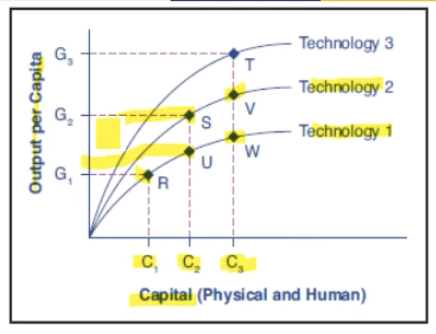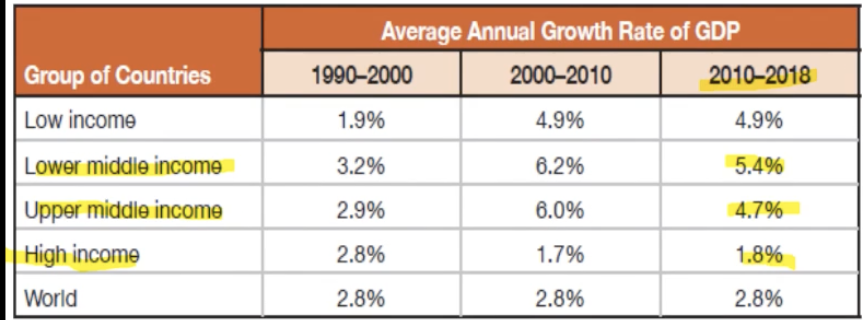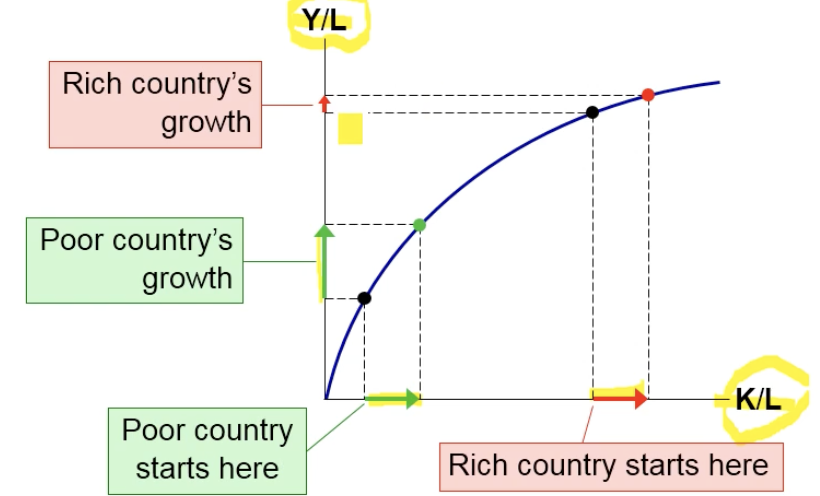Econ 13: Chapter 8 Economic Growth
1/23
There's no tags or description
Looks like no tags are added yet.
Name | Mastery | Learn | Test | Matching | Spaced |
|---|
No study sessions yet.
24 Terms
What is economic growth?
An increase in productivity. When a GDP of a country keeps on growing.
Calculate how long it will take for a GDP of 100 to double with 2.5% growth rate
100(1+0.025) ^x = 200
x = 28
if the annual economic growth rate is a few percentages, what difference does it make on the economy?
Even just 3% or 5%, it can make an enormous difference in per capita GDP.
See how 8% in 10 years already doubled the GDP of 100 at the start

Formula for Growth rate of GDP over different time horizons
GDP at starting date x (1 + growth rate of GDP) ^ years = GDP at end date
What is productivity?
The value of what is produced per worker OR per hour worked
What does a countries standard of living depend on?
Goods and services
How do you measure productivity?
Productivity = Y/L (output per worker)
Y = real GDP, aka quantity of output produced
L = quantity of labor
Why is productivity so important?
Real GDP is large, so incomes are high
Living standards grow
What determines productivity and its growth rate?
Physical Capital, K
Human Capital, H
Natural Resources, N
Technological Knowledge
Physical Capital, K
The stock of equipment and structures used to produce g&s
K/L = capital per worker
When an average worker has more machines n equipment, productivity is higher, increase in K/L…increase in Y/L
Human Capital, H
the knowledge and skills workers acquire through education, training, and experience.
H/L = the average workers human capital
When a worker has more education and skills, their productivity is higher, increase H/L …increase Y/L
Natural Resources, N
the inputs into production, that nature provides. land, mineral deposits
N/L = number of workers to the quantity of land
When some countries have more natural resources, they are richer
when other things are equal, increase N/L …increase Y/L
Do countries need natural resources to be rich?
Not necessarily, some countries are rich because of their abundant resources
some countries are rich because they import the N needs
Technological Knowledge
society’s understanding of the best ways to produce g&s - (It doesn’t mean technological progress, like faster computer or higher-definition TV)
It means any advance knowledge that boost productivity, allows society to get more output from its resources. Ex: assembly line
The aggregate production function
certain inputs, eg. H, K, A, lead to outputs
measured as GDP/Capita
What is the production function?
The process of a firm turning economic inputs like labor, machinery, and raw materials into outputs like goods and services used by consumers.
What’s the production function formula?
Y =A F(L, K, H, N)
A = the level of technology
L = labor
K = Physical Capital
H = Human Capital
N = Natural Resources
What is capital deepening?
When an economy has a higher average level of physical and/or human capital per person.
Why is technology important for economic growth?
technology is new ways of producing stuff
to grow per capita GDP, is to improve H, K, and technology

What is convergence aka the catch up effect?
Poorer economies tend to grow faster than richer ones, and over time, their income levels or per capita GDP will become similar or "converge."

What is diminishing marginal return?
Growth Rate slows down
As more inputs are added, the additional output by each additional unit will eventually decrease, holding all other factors constant.

Why don’t all economies converge?
Not converging
slow growth
lower standards of living
trapped
BC of…
High birth rates
unstable economic development
no institutions
bad infrastructures
civil war
What are some policies that affect growth n productivity in the long run?
Saving and investment
investments from abroad
education
heath n nutrition
institutions, systems w/ property rights & political stability
R & D, source of new tech
In the long run, what is output determined by?
The quantity of inputs and their productivity